
Palazzo Durazzo-Pallavicini or Palazzo di Gio Agostino Balbi is a building on Via Balbi in the historic city centre of Genoa. On 13 July 2006 it became one of 42 palazzi included in the new Palazzi dei Rolli World Heritage Site. [1]

Palazzo Durazzo-Pallavicini or Palazzo di Gio Agostino Balbi is a building on Via Balbi in the historic city centre of Genoa. On 13 July 2006 it became one of 42 palazzi included in the new Palazzi dei Rolli World Heritage Site. [1]
This section needs additional citations for verification .(May 2023) |
Its architecture is thought of as being the link between the residential models of Strada Nuova and the compositional solutions of Via Balbi. It was designed by Bartolomeo Bianco for Gio. Agostino Balbi early in the 17th century, ably meeting the client's request for a traditional U-shaped floor plan despite the triangular plot of land available. A strong architectural element of the design is the nucleus of the diverging stairs on the courtyard, separated by a monumental staircase: a real path covered by the rooms on the mezzanine floor. Also typical of the architect is the use of the external spaces which are divided to the east and the west, allowing a gradual view of the hanging gardens along the road.
The building was added to the Rollo of 1664 in the first Bussolo, the highest category, intended to host cardinals, princes, viceroys and governors. Financial problems forced the new owner, Bartolomeo Balbi, to rent out part of the building to Giuseppe Maria Durazzo. He finally sold the whole building to Marcello Durazzo in 1710. From 1735 onwards the main floor rooms were redecorated by Giacomo Boni, Giuseppe Davolio, Paolo Gerolamo Piola and Francesco Maria Costa. [2] In 1774 the architect Emanuele Andrea Tagliafichi was commissioned to design the area upstream of the building.
It houses one of the most important private art collections in Italy, including works by Titian, Francesco Albani, Brueghel the Elder, Carracci, Valerio Castello, Domenichino, Anthony Van Dyck, Grechetto, Luca Giordano, Guercino, Guercino, Magnasco, Mulinaretto, Piola, Procaccini, Reni, Ribera, Rubens and Strozzi. [2] It also has a large archive holding papers on many members of the families inhabiting the house who have influenced Genoa's history, though the Palazzo's library and manuscript collection commissioned by Giacomo Filippo Durazzo in the 18th century were recently transferred to the Palazzo Durazzo Pallavicini in Luccoli - it belonged to the Durazzo family in the same way as the Royal palace, also located in via Balbi and the main residence of the family, sold by Marcello Durazzo to King Carlo Felice in 1824 and which became the State Museum, of the Durazzo alla Meridiana palace, the last residence of the Durazzo family, of the Durazzo-Centurione villa in Santa Margherita Ligure, municipal property and of many other buildings that belonged to the Genoese family - it also belonged to the Durazzo family like the palazzo Reale (also on the via Balbi, which was the family's main residence until sold to king Carlo Felice in 1824 by Marcello Durazzo, becoming a State Museum), Palazzo Durazzo alla Meridiana (the Durazzo family's last residence), Villa Durazzo-Centurione di Santa Margherita Ligure (city property) and many other buildings belonging to that family.

The Italian Riviera or Ligurian Riviera is the narrow coastal strip in Italy which lies between the Ligurian Sea and the mountain chain formed by the Maritime Alps and the Apennines. Longitudinally it extends from the border with France and the French Riviera near Ventimiglia eastwards to Capo Corvo which marks the eastern end of the Gulf of La Spezia and is close to the regional border between Liguria and Tuscany. The Italian Riviera thus includes nearly all of the coastline of Liguria. Historically the "Riviera" extended further to the west, through what is now French territory as far as Marseille.

Balbi may refer to:
Clelia Durazzo Grimaldi (1760–1830), also known as Clelia Durazzo, was a botanist and marchesa in Genoa, Italy.
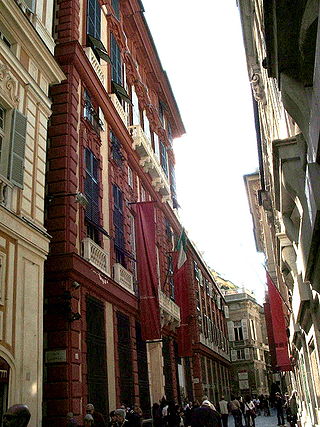
Via Giuseppe Garibaldi is a street in the historical centre of Genoa, in Northwestern Italy, well known for its ancient palaces. It is one of the Strade Nuove built by the Genoese aristocracy during the Renaissance. Since July 2006 it is inscribed in the list of UNESCO World Heritage Site Genoa: the Strade Nuove and the system of the Palazzi dei Rolli.

The Palazzo Brignole Sale or Palazzo Rosso is a house museum located in Via Garibaldi, in the historical center of Genoa, in Northwestern Italy. The palace is part of the UNESCO World Heritage Site Genoa: Le Strade Nuove and the system of the Palazzi dei Rolli. The rich art collection inside, along with the galleries of Palazzo Bianco and Palazzo Doria Tursi, is part of the Musei di Strada Nuova and consists of the works of artists of the caliber of Antoon van Dyck, Guido Reni, Paolo Veronese, Guercino, Gregorio De Ferrari, Albrecht Dürer, Bernardo Strozzi and Mattia Preti.

Genoa: Le Strade Nuove and the system of the Palazzi dei Rolli is a UNESCO World Heritage Site which includes a number of streets and palaces in the center of Genoa, in Northwestern Italy.
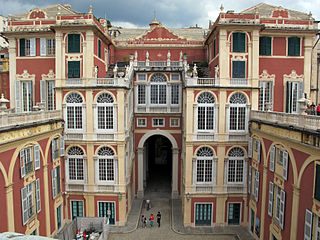
The Palazzo Reale or Palazzo Stefano Balbi is a major palace in Genoa.
The following is a timeline of the history of the city of Genoa, Liguria, Italy.

Genoa is a city in and the capital of the Italian region of Liguria, and the sixth-largest city in Italy. In 2023, 558,745 people lived within the city's administrative limits. While its metropolitan area has 813,626 inhabitants. Over 1.5 million people live in the wider metropolitan area stretching along the Italian Riviera.
Palazzo Spinola or Spinola Palace may refer to:

The Palazzo Angelo Giovanni Spinola is a palace located in Via Garibaldi, in the historical center of Genoa, in Northwestern Italy. It was one of the 163 Palazzi dei Rolli of Genoa, the selected private residences where the notable guests of the Republic of Genoa were hosted during State visits. On 13 luglio del 2006 it was included in the list of 42 palaces which now form the UNESCO World Heritage Site Genoa: Le Strade Nuove and the system of the Palazzi dei Rolli. Now owned by a bank, it is possible to visit the areas open to the public.

The Palazzo Doria or Palazzo Andrea e Gio. Batta Spinola is a palace located in Via Garibaldi, in the historical center of Genoa, in Northwestern Italy. It was one of the 163 Palazzi dei Rolli of Genoa, the selected private residences where the notable guests of the Republic of Genoa were hosted during State visits. On 13 luglio del 2006 it was included in the list of 42 palaces which now form the UNESCO World Heritage Site Genoa: Le Strade Nuove and the system of the Palazzi dei Rolli.

The Palazzo Spinola di Pellicceria, also known as Palazzo Francesco Grimaldi, is a palace located in piazza di Pellicceria in the historical center of Genoa, Northwestern Italy. The palace was one of the 163 Palazzi dei Rolli of Genoa, the selected private residences where the notable guests of the Republic of Genoa were hosted during State visits. On 13 luglio del 2006 it was added to the list of 42 palaces which now form the UNESCO World Heritage Site Genoa: Le Strade Nuove and the system of the Palazzi dei Rolli. It is currently owned by the Ministry of Cultural Heritage and Activities and Tourism and houses the National Gallery of Art in Palazzo Spinola.
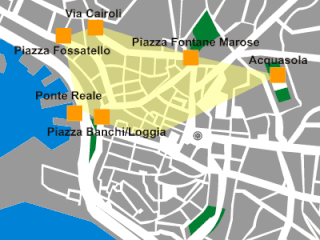
Maddalena is a neighbourhood in the old town of the Italian city of Genoa. It was one of the six sestieri of ancient Genoa. At present it is part of the Genoa's city Municipio I.
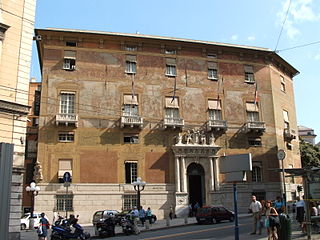
The Palazzo Doria-Spinola or Palazzo Antonio Doria is a palace located in largo Eros Lanfranco in the historical center of Genoa, Northwestern Italy. The palace was one of the 163 Palazzi dei Rolli of Genoa, one of those selected private residences where notable guests of the Republic of Genoa were hosted during State visits. On 13 luglio del 2006 it was added to the list of 42 palaces which now form the UNESCO World Heritage Site Genoa: Le Strade Nuove and the system of the Palazzi dei Rolli. The palace now hosts the Prefecture of Genoa and the seat of the Province of Genoa. It is possible to visit the areas of the building which are open to the public.
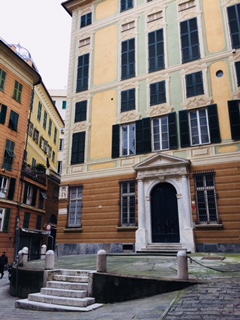
The Palazzo Clemente della Rovere is a palace located in Piazza Rovere in the historical center of Genoa, Northwestern Italy. The palace was one of the 163 Palazzi dei Rolli of Genoa, the selected private residences where the notable guests of the Republic of Genoa were hosted during State visits. On 13 luglio 2006 it was added to the list of 42 palaces which now form the UNESCO World Heritage Site Genoa: Le Strade Nuove and the system of the Palazzi dei Rolli. The palace hosts today the General Consulate of Iceland.

Villa Balbi Durazzo Gropallo "Dello Zerbino" is a 16th-century villa in Genoa, Italy. It is situated in the quarter of Castelletto, near Galeazzo Alessi's Villa delle Peschiere. It was constructed from 1599 to 1603 as a suburban villa for the Genoese noblemen Stefano Balbi, ambassador to Milan, and Giovanni Battista Balbi. The name Zerbino is derived from the Ligurian word zerbo, meaning "uncultivated"— at the time when the villa was built, the surrounding area was still outside of the city walls and uncultivated. In the 18th century it passed to Marcello III Durazzo, then to the Gropallo family. It is now owned by the Castelbarco Albani family and used as a venue for events and exhibitions.

Via Balbi is a street in the historical centre of Genoa, in Northwestern Italy, named after the aristocratic Genoese Balbi family. It is one of the Strade Nuove built by the Genoese aristocracy during the Renaissance. Since July 2006 it is inscribed in the list of UNESCO World Heritage Site Genoa: the Strade Nuove and the system of the Palazzi dei Rolli.

Via Cairoli is a street in the historical centre of Genoa, in North-western Italy, named after the 10th Prime Minister of Italy Benedetto Cairoli (1825-1889). Built in the 18th century as “Strada Nuovissima”, it is one of the Strade Nuove inscribed in July 2006 in the list of UNESCO World Heritage Site Genoa: the Strade Nuove and the system of the Palazzi dei Rolli.

The palazzo Doria-Tursi or palazzo Niccolò Grimaldi is a building on Via Giuseppe Garibaldi in the historic town centre of Genoa. With Palazzo Rosso and Palazzo Bianco it houses the Strada Nuova Museums and on 13 July 2006 all three palaces and the streets around them became the Genoa: Le Strade Nuove and the system of the Palazzi dei Rolli World Heritage Site. Since 1848 Palazzo Doria-Tursi has also housed the city hall of Genoa.